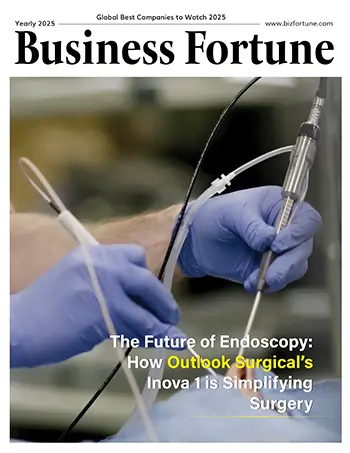Home Innovation Science and Technology Innovations in Brain Shuttle: ...
Innovations in Brain Shuttle: How New Drug Delivery Technologies Are Offering Hope for Alzheimer’s, Cancer, and Rare Genetic Disorders
Science and Technology

Business Fortune
02 June, 2025
Some diseases are inherited, meaning they are passed on from one generation to the next. People frequently have to witness their loved ones' suffering as a result, which is a very unpleasant experience.
Heritable genome editing may be a viable way for many prospective parents who are known to be at risk of passing on a serious genetic disease to their offspring to have genetically related children who are not afflicted by that disease.
Daiza Gordon was a teenager when she saw the deaths of her two younger brothers. They had Hunter syndrome, a rare and incurable condition that primarily affects males and is caused by the absence of a gene for a crucial enzyme. When her attempts to revive her younger brother failed, guilt made her anguish worse. She was only nineteen.
Gordon went on to learn about the harshness of genetics. The problem was present in all three of her own boys from birth. The symptoms, which included thickening of facial features, loss of mobility, hearing, and language, as well as other effects on mental and physical development, began to show up when her two oldest children became two years old.
However, she sees hope for her boys that her brothers were not given. The technique to deliver iduronate-2-sulfatase (IDS), a substitute for the missing enzyme, into the brain is being tested in a clinical trial with her children. According to preliminary findings, several of the physical and cognitive symptoms of the illness have improved. Gordon's oldest boys have begun to run around and are no longer deaf. She never would have imagined that they would reach these developmental milestones. None of the early signs are present in her two-year-old, who began the treatment at the age of three months. Gordon claims that she recognizes they have a shot for a true future when she looks at them.
For the past twenty years, the standard of therapy has been a routine infusion of replacement IDS, which shields vital organs, including the kidneys and liver, from harm. However, without assistance, the big enzyme is unable to get past the barrier that keeps blood from reaching the brain, one of the most vital organs.
Gordon's children benefit from a novel molecular transport method, which involves attaching a chemical tag to IDS and guiding it across the densely packed cells that comprise the blood–brain barrier. A number of these shuttles are now under development, utilizing the brain's inherent transport networks. These shuttles have the potential to transform neuropharmacology by transporting big biological medicines, including proteins, antibodies, and viruses employed in gene therapy. And it applies not only to uncommon illnesses like Hunter syndrome but also to prevalent brain ailments like cancer and Alzheimer's disease.
James Gorman, chief investigator of Harvard University's Wyss Institute Brain Targeting Program in Boston, Massachusetts, says the field is still in its early stages, and there is still much to learn about how to direct big therapeutic molecules to the precise locations in the brain where they are required. Still, the enthusiasm is evident. "Every big company in this industry seems to have a program to develop brain shuttles," he remarked.
Breaking Through the Blood-Brain Barrier: Creative Methods for Biological Drug Delivery to the Brain
The blood-brain barrier, which is made up of around 650 kilometers of blood arteries lined with closely spaced endothelial cells, is what protects the human brain, which is housed in a sac filled with cerebrospinal fluid. Toxins are blocked by this barrier, but vital molecules like oxygen may flow through. Other chemicals, like iron and glucose, rely on specific transporters that are incorporated into the cells.
Drugs are usually made by pharmaceutical companies to be tiny and fat-soluble in order to readily pass the barrier. However, the barrier presents a major problem for big biological therapies that can address problems like protein clumping or enzyme replacement. Recent FDA approvals of antibodies that target amyloid particles in Alzheimer's disease are an example of this issue, as less than 0.1% of an intravenous dose reaches the brain.
Antibodies enter the brain indirectly through cerebrospinal fluid from blood veins with a weaker barrier, according to research. This is an unreliable route that can lead to inflammation and ineffective medicine distribution. For over 25 years, researchers have been investigating more direct approaches. The transferrin receptor, which carries iron across the blood-brain barrier, is one promising strategy. Researchers hope to enable more efficient delivery of big biological medications without interfering with the receptor's natural function by creating a construct that binds therapeutic chemicals to target this receptor.
Hunter Syndrome and Other Genetic Disorders Have New Hope Because Of Brain Shuttle Therapies
For a variety of brain disorders, shuttle-based treatments are now being developed. It's now quite evident that we can get these medications over the blood-brain barrier, according to Gorman. Our biggest challenge is figuring out how to effectively get them to the appropriate location inside the brain for various illnesses and payloads.
Brain shuttles work very effectively for some disorders. One of the first to reap the benefits was Hunter syndrome. It belongs to a group of uncommon genetic disorders called lysosomal storage diseases. IDS is one of the enzymes found in lysosomes, which are subcellular waste-processing centers that break down waste products in cells.
The replacement enzyme must be in the lysosome, so it's ideal that cells view foreign proteins like therapeutic IDS as waste and send them there, according to Gorman.


































.webp)